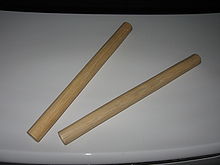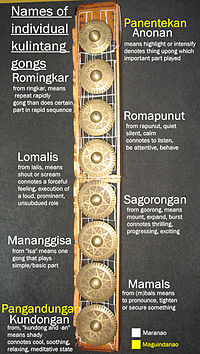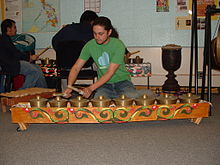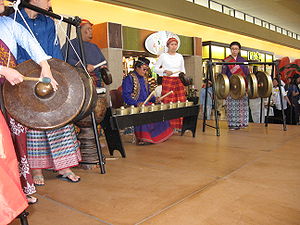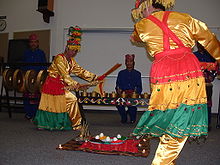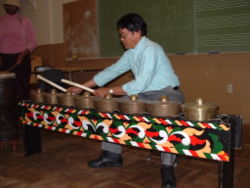- Kulintang
-
Kulintang 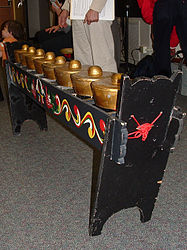
Other names Kolintang, Kulintangan, Totobuang Classification Playing range Pelog and Slendro scales Related instruments bonang,[1] kenong, canang, keromong,[2] kromong, kethuk,[3] trompong/terompong, rejong, talempong,[4] chalempung, caklempong/caklempung,[2] khong wong yai/khong wong lek, khong toch/ khong thom, khong vong, krewaing/krewong[5] More articles gamelan and piphat Kulintang ensemble Stylistic origins Music of Southeast Asia Typical instruments Kulintang • Agung • Gandingan • Babendil • Dabakan Mainstream popularity Mainstream in parts of Southeast Asia, limited success elsewhere. Kulintang is a modern term for an ancient instrumental form of music composed on a row of small, horizontally-laid gongs that function melodically, accompanied by larger, suspended gongs and drums. As part of the larger gong-chime culture of Southeast Asia, kulintang music ensembles have been playing for many centuries in regions of the Eastern Malay Archipelago — the Southern Philippines, Eastern Indonesia, Eastern Malaysia, Brunei and Timor,[6] although this article has a focus on the Philippine Kulintang traditions of the Maranao and Maguindanao peoples in particular. Kulintang evolved from a simple native signaling tradition, and developed into its present form with the incorporation of knobbed gongs from Sunda.[5] Its importance stems from its association with the indigenous cultures that inhabited these islands prior to the influences of Hinduism, Buddhism, Islam, Christianity or the West, making Kulintang the most developed tradition of Southeast Asian archaic gong-chime ensembles.
Technically, kulintang is the Maguindanao, Ternate and Timor term for the idiophone of metal gong kettles which are laid horizontally upon a rack to create an entire kulintang set.[7] It is played by striking the bosses of the gongs with two wooden beaters. Due to its use across a wide variety groups and languages, the kulintang is also called kolintang by the Maranao and those in Sulawesi, kulintangan, gulintangan by those in Sabah and the Sulu Archipelago and totobuang by those in central Maluku.[8]
By the twentieth century, the term kulintang had also come to denote an entire Maguindanao ensemble of five to six instruments.[9] Traditionally the Maguindanao term for the entire ensemble is basalen or palabunibunyan, the latter term meaning “an ensemble of loud instruments” or “music-making” or in this case “music-making using a kulintang.”[10]
Contents
Geographic extent
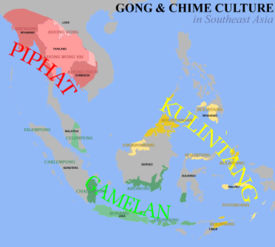 Map of kulintang music in Southeast Asia.
Map of kulintang music in Southeast Asia.
Kulintang belongs to the larger unit/stratum of “knobbed gong-chime culture” prevalent in Southeast Asia. It is considered one of the region’s three major gong ensembles, alongside the gamelan of western Indonesia and piphat of Thailand, Burma, Cambodia and Laos, which use gongs and not wind or string instruments to carry the melodic part of the ensemble. Like the other two, kulintang music is primarily orchestral with several rhythmic parts orderly stacked one upon another. It is also based upon the pentatonic scale. However, kulintang music differs in many aspects from gamelan music, primarily in the way the latter constructs melodies within a framework of skeletal tones and prescribed time interval of entry for each instruments. The framework of kulintang music is more flexible and time intervals are nonexistent, allowing for such things as improvisations to be more prevalent.[4]
Because kulintang-like ensembles extended over various groups with various languages, the term used for the horizontal set of gongs varied widely. Along with it begin called kulintang, it is also called kolintang, kolintan, kulintangan,[11] kwintangan, k’lintang, gong sembilan, gong duablas, momo, totobuang, nekara,[12] engkromong, kromong/enkromong and recently kakula/kakula nuada. Kulintang-like instruments are played by the Maguindanao, Maranao, Iranun, Kalagan, Kalibugan and more recently the Tboli, Blaan and Subanao of Mindanao, the Tausug, Samal, Sama/Badjao, Yakan and the Sangir/Sangil of the Sulu, the Ambon, Banda, Seram, Ternate, Tidore, and Kei of Maluku, the Bajau, Suluk, Murut,[13] Kadazan-Dusun, Kadayah and Paitanic Peoples of Sabah, the Malays of Brunei, the Bidayuh and Iban/Sea Dayak of Sarawak, the Bolaang Mongondow and Kailinese/Toli-Toli of Sulawesi and other groups in Banjarmasin and Tanjung[14] in Kalimantan and Timor.
Instrument
Description
The instrument called the “kulintang” (or its other derivative terms) consist of a row/set of 5 to 9 graduated pot gongs, horizontally laid upon a frame arranged in order of pitch with the lowest gong found on the players’ left.[15] The gongs are laid in the instrument face side up atop two cords/strings running parallel to the entire length of the frame, with bamboo/wooden sticks/bars resting perpendicular across the frame creating an entire kulintang set called a pasangan.[16]
The gongs could weigh roughly from two pounds to three and 1/8 pounds and have dimensions from 6–10 inches for their diameters and 3–5 inches for their height.[17] Traditionally they are made from bronze but due to the shortage of bronze after World War II, and the subsequent use of scrap metal, brass gongs with shorter decaying tones have become commonplace.
The kulintang frame known as an antangan by the Maguindanao (means to “arrange”) and langkonga by the Maranao could have designs that could be particularly crude made from only bamboo/wooden poles or highly decorated, rich with artistic designs like the traditional okil/okir motifs or arabesque designs. It is considered taboo to step or cross over the antangan while the kulintang gongs are placed on it.[18]
Technique
The kulintang is played by striking the bosses of the gongs with two wooden beaters. When playing the kulintang, the Maguindanao and Maranao would always sit on chairs while for the Tausug/Suluk and other groups that who play the kulintangan, they would commonly sit on the floor.[19] Modern techniques include twirling the beaters, juggling them in midair, changing the arrangement of the gongs either before or while playing, crossings hands during play or adding very rapid fire strokes all in an effort to show off a player’s grace and virtuosity.[8]
Casting
Kulintang gongs are made using the cire perdue method, a lost-wax process used for casting the individual gongs.[20] The first phase is the creation of wax molds of the gongs. In the past, before the availability of standardized wax sheets made specifically for foundry use, the molds were made out of either beeswax (talo) or candle wax (kandila).[5] The wax mold is covered with a special mixture of finely-powdered coal/mud, which is applied on the wax surface using a brush. The layers are then left to dry under the sun, after which the entire mold is heated in a furnace to melt away the wax and hardening the coal/mud mixture, leaving behind a hollowed shell.[4] With this hardened mold, molten bronze is poured down the mold’s mouth cavity, cooled to a certain degree, then the coal/mud is broken apart, revealing a new gong. The gong is then refined, cleaned, and properly identified by the panday (blacksmith).[7] Finally, the finished product is refined using the tongkol process, tuning the gongs either by hammering the boss from the inside to slightly raise its pitch, or by hammering the boss from the outside to lower the pitch.[4] The correct tuning is found by ear, with players striking a sequence of gongs, looking for a melodic contour they are familiar with.[21]
Tuning
Unlike westernized instrumentation, there is no set tuning for kulintang sets throughout the Philippines.[22] Great variation exist between each set due to differences in make, size and shape, alloy used giving each kulintang set a unique pitch level, intervals and timbre.[23] Though the tuning varies greatly, there does exist some uniformity to contour when same melody heard on different kulintang sets.[20] This common counter results in similar interval relationships of more or less equidistant steps between each of the gongs.[24] This tuning system, not based upon equal temperament or upon a system of standard pitches but on a similar/certain pattern of large and small intervals, could also be found among the gamelan orchestras of western Indonesia.[21] In fact, though the Maguindanao, Maranao and Tausug artists technically have no concept of scale (because emphasis placed on the concept of “rhythmic modes”), the Pelog and Slendro scales of Java were found to be most satisfactory to their own varying pentatonic/heptatonic scales.
Notation system
Because this music was catered for by acephalous societies, kulintang repertory was unfettered by an indigenous notation system.[21] Compositions were passed down orally from generation to generation negating the need for notation for the pieces.[25] Recent attempts have been made to transcribe the music using cipher notation, with gongs indicated by a numbering system for example, starting from 1 to 8 with the lowest gong starting at number 1 for an eight gong kulintang set.[20]
Feminine instrument
The kulintang is traditionally considered a women’s instrument by many groups: the Maguindanao, Maranao, Tausug/Suluk, Samal, Badjao/Sama, Iranun, Kadazan, Murut, Bidayuh and Iban.[26] Traditionally, the playing of the kulintang was associated with graceful, slow, frail and relaxed movements that showed elegance and decorum common among females.[27] Nowadays, with both women and men playing all five instruments, the kulintang seen strictly as a woman’s instrument has waned, and in fact today, the most well known players of the kulintang happen to be men.[28]
Performance
The main purpose for kulintang music in the community is to function as social entertainment at a nonprofessional, folk level.[27] This music is unique in that it is considered a public music in the sense everyone is allowed to participate.[9] Not only do the players play, but audience members are also expected to participate.[17] These performances are important in that they bring people in the community and adjacent regions together, helping unify communities that otherwise may not have interacted with one another. Traditionally, when performers play kulintang music, their participation is voluntary.[8] Musicians see performances as an opportunity to receive recognition, prestige and respect from the community and nothing more.[28]
Generally, performances can be classified as either formal ones or informal. During formal performances adherents follow a traditional set of rules that would govern playing and it usually involved people from outside the home. Informal performances are quite the opposite. The strict rules that normally govern play are often ignored and the performers are usually between people well acquainted with one another, usually close family members.[8] These performances usually were times when amateurs practiced on the instruments, young boys and girls gathered the instruments, substituting the kulintang with the saronay and inubab.[7] Ensembles didn’t necessary have to have five instruments like formal performances: they could be composed of only four instruments (three gandingan gongs, a kulintang, an agung, and a dabakan), three instruments (a kulintang, a dabakan, and either an agung or three gandingan gongs) or simply just one instrument (kulintang solo).[4]
Social functions
Kulintang music generally could be found as the social entertainment at a host of different occasions. It is used during large feasts, festive/harvest gatherings, for entertainment of visiting friends and relatives, and at parades.[1] Kulintang music also accompanies ceremonies marking significant life events, such as weddings and returnees from the Hajj.[19] Kulintang music also plays a significant role during state functions, used during official celebrations, entertaining of foreign dignitaries and important visitors of distant lands, court ceremonies of either the sultanate or village chieftains, enthroning/coronations of a new leader and the transferral of a sultanate from one family to another.[12]
Kulintang music is prohibited from being played inside mosques[28] and during Islamic rites/observances/holidays, such as the fasting month (Ramadhan), where playing is only allowed at night during the time when people are allowed to eat.[8] It is also prohibited during the mourning period of the death of important person, during funerals, and during the peak times of the planting and harvest season.[2]
 The gandingan is normally chosen for playing apad renditions
The gandingan is normally chosen for playing apad renditions
Other uses
Kulintang instrument has uses other than public performances. It also is used to accompany healing ceremonies/rituals (pagipat)/animistic religious ceremonies. Though this practice has died out among the Maranao due to its non-Islamic nature, some areas in Mindanao, Sabah and Maluku still practice this ancient tradition.[8]
Kulintang music can be used for communicating long distance messages from one village or longhouse to another.[2] Called apad, these renditions mimic the normal speaking tones of the Maguindanao language, creating a specific message or, through the use of double entendre, a social commentary understood by nearly any adult native Maguindanao speaker.[29] However, apad is falling into disuse because times have changed, and the necessity of its use for long-distance communication purposes has faded away. Anun as a music without a message, is used instead to express sentiments and feelings, and has come more and more into use due to its compatibility with the musical elaborations and idiosyncratic styles of the times.[7]
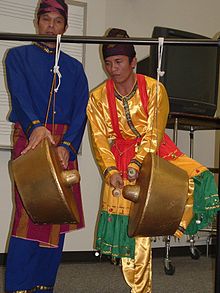 An agung contestant performing on the agung using two balus.
An agung contestant performing on the agung using two balus.
Kulintang music was also crucial in relation to courtships[30] due to the very nature of Islamic custom, which did not allow for unmarried men and women to intermingle.[25] Traditionally, unmarried daughters were kept in a special chamber in the attic called a lamin, off-limit to visitors and suitors.[8] It was only when she was allowed to play during kulintang performances that suitors were allowed to view her. Because of this, kulintang music was rare socially approved vehicles for interaction among the sexes.[28]
Musical contest, particularly among the Maguindanao, have become a unique feature of these kulintang performances.[7] They occur at almost all the formal occasions mentioned above, particularly weddings.[17] What has made the Maguindanao stand out from the other groups is that they practice solo gong contest – with individual players showcasing their skill on the various ensemble instruments – the agung, gandingan and the kulintang – as opposed to only group contest, where performers from one town and another town are pitted against each other.[28]
Compositions
Rhythmic modes
Kulintang music has no set compositions due to its concept of rhythmic modes.[6] A rhythmic mode (or designation or genre or pattern) is defined as a musical unit that binds together the entire five instrument ensemble.[27] By adding together the various rhythms of each instrument, one could create music and by changing one of the rhythms, one could create different music.[6] This is the basis of the rhythmic mode.
Improvisation
The kulintang player’s ability to improvise within the parameters of a rhythmic mode is a must.[21] As with gamelan orchestras, each kulintang mode has a kind of theme the kulintang player “dresses up” by variations of ornamentation, manipulating segments by inserting repetitions, extensions, insertions, suspensions, variations and transpositions. This occurs at the discretion of the kulintang player.[27] Therefore, the kulintang player functions not only as the one carrying the melody, but also as the conductor of the entire ensemble. She determines the length of each rendition and could change the rhythm at anytime, speeding up or slowing down, accord to her personal taste and the composition she plays.[31]
This emphasis on improvisation was essential due traditional role of the music as entertainment for the entire community.[32] Listeners in the audience expected players to surprise and astound them by playing in their own unique style, and by incorporating improvisation to make newer versions of the piece.[8] If a player simply imitated a preceding player, playing patterns without any improvisation, the audience members would believe she/he to be repetitious and mundane.[33] This also explains why set performance pieces for musical productions are different in some respect — young men/women would be practicing before an event, therefore rarely relying on improvisations.[28]
Maguindanao and Maranao compositions
Though allowing such a variety of rhythms would lead to an innumerable amount of patterns, generally one could categorize these rhythmic modes on the basis on various criteria such as the number of beats in a recurring musical phrase, differences in the melodic and rhythmic groups with the musical phrase, differences in the rhythmic emphasis, and differences in the opening formulas and cadential patterns.[7] For the Maguindanao, three to five typical genres can be distinguished:[27] Duyug, Sinulog, Tidtu, Binalig and Tagonggo.[32] The Maranao on the other hand have only three typical genres — Kapromayas/Romayas, Kapagonor/Onor, and Katitik Pandai/Kapaginandang.[20]
These general genres could be further grouped among each other into styles/subcategories/stylistic modifiers,[7] which are differentiated from one another based on instrumentation, playing techniques, function and the average age and gender of the musicians as well.[31] Generally, these styles are differentiated by what is considered traditional or “old,” and more contemporary or “new.”
Old styles are considered slow, well-pronounced and dignified like the Maguindanao’s kamamatuan and the Maranao’s andung.[23] Genres classified under this style have moderate tempos, are rhythmically-oriented, balanced, lack many improvisations and are usually played by the older folks and are therefore always played first, to give due respect to the older generation.[31]
New styles such as the Maguindanao’s kagungudan and the Maranao’s bago, are considered fast, rhythmic and showy.[10] Generally genres under this classification have faster tempos with an emphasis on power and speed, are highly rhythmic and pulsating, and are highly improvised with musicians employing different rhythmic/melodic formulae not used with old patterns.[4] “Young” musicians, specifically young men, gravitate toward this style because of its emphasis on virtuosity and one’s individualism.[31] Generally played after all kamamatuan pieces have been played to give younger musicians the opportunity to participate.[17] Tagunggo not classified under one of these styles, being more ritualistic than recreational in nature.[16] Tagunggo is a rhythmic mode often used to accompany trance and dance rituals such as sagayan.[33] During the playing of these pieces, a ritual specialist would dance in rhythm with the music calling on the help of ancestral spirits (tunong).[7]
Sulu-type kulintangan compositions
Sulu-type compositions on the kulintangan are found among the Tausug, Samal, Yakan, Sama/Badjao, Iranun and Kadazan-Dusun. Though there exist no identifiable rhythmic or melodic differences between patterns with names such as the Maguindanao, each group has their own music compositions. For instance, the Tausug have three identifiable compositions — Kuriri, Sinug, and Lubak-Lubak — the Yakan have two — Tini-id and Kuriri — and the Dusun have three — Ayas, Kudidi and Tidung. Though these melodies vary even within groups like the Maguindanao and Maranao, one theme which characterizes the Sulu-type is the exchange of short melodic phrases between the kulintangan and the Agungs, where both instruments imitate and duplicate each others rhythms very quickly. This is clearly seen in the Tausug Sinug and Yakan Tini-id and Kuriri compositions where this sort of jousting becomes a game of skill and virtuoso playing.[4]
Composition titles
The kulintang repertoire has no fixed labels because the music itself is not considered a fixed entity. Due to the fact it is orally transmitted, the repertoire itself is considered something always in a state of flux due to two primary reasons. First, standardized titles weren’t considered a priority. Though to the musicians themselves the melodies would sound similar, the labels they would place on a particular rhythmic mode or style could vary even from household to household within that same village. For the musicians, the emphasis is on the excitement and pleasure of playing the music without much regard to what the piece was referred to as. Secondly, because musicians improvised their pieces regularly, modes and styles were continually revised and changed as they were passed on to a newer generation of musicians, making the pieces and therefore the labels attached to them relevant only during a certain frame of time.
Such issues made attempts to codify the compositions in a uniform manner impossible.[27] An example of this could be found among the Maguindanao where the word binalig is used by contemporary musicians as a name for one of the rhythmic modes associated with kangungudan but it has also been used as a term designating a “new” style.[34] Another example concerns the discrepancy among “old” and “new” genres. With “new pieces” continuously proliferating even up till now, pieces only created decades ago are now considered “old” even though this is considered a tradition spanning many centuries.[27] These differences could sometimes make discussing this repertoire and the modes and styles within it a bit confounding.
History
Kulintang music is considered an ancient tradition that predates the influences of Islam, Christianity, and the West. In the Philippines, it represents the highest form of gong music attained by Filipinos[7] and in North Maluku, it is said to have existed for centuries.[12]
As ancient as this music is, there has never been substantial data recorded regarding the kulintang’s origins.[5] The earliest historical accounts of instruments resembling those of the present day kulintang are in the writings of various European explorers from the 16th century who would have seen such instruments used in passing.[35][36][37]
Because of limited data concerning gong music prior to European exploration, theories abound as to when the prototypes of what is now the present day kulintang came to be. One theory suggest that the bronze gong had an ancient history in Southeast Asia, arriving in the Malay archipelago two or even three thousand years ago, making its way to the Philippines from China in the 3rd century AD.[38] Another theory lays doubt to the former claim, suggesting the kulintang could not have existed prior to 15th century due to the belief Javanese gong tradition, which is what the kulintang was believed to be derived from, developed only by the 15th century.[39]
Though different theories abound as to the exact centuries the kulintang was finally realized, there is a consensus that kulintang music developed from a foreign musical tradition which was borrowed and adapted to the indigenous music tradition already present in the area.[4] It’s likely the earliest gongs used among the indigenous populace had no recreational value but were simply used for making signals and sending messages.[1]
Kulintang music likely evolved from this simple signaling tradition, transitioning into a period consisting of one player, one-gong type ensembles (like those found among the Ifugao of Luzon or Tiruray of Mindanao), developing into a multi-gong, multiplayer ensemble with the incorporation of concepts originating from Sunda and finally transforming into the present day kulintang ensemble, with the addition of the d’bakan, babndir and musical concepts of Islam via Islam traders.
Origin of the gong
 Two proposed routes for the migration of the kulintang gong to Mindanao
Two proposed routes for the migration of the kulintang gong to Mindanao
The kulintang gong itself is believed to be have been one of those foreign musical elements incorporated into kulintang music, derived from the Sundanese kolenang due to its striking similarities.[5] Along with the fact that they play important roles in their respectively ensembles, both the kulintang and kolenang show striking homogeneity in tapered rims (as opposed to pronouncedly tapered Javanese bonang and non-tapered Laotian khong vong gongs). Even the word kulintang is believed to be just an altered form of the Sundanese word kolenang.[40]
It was these similarities that lead theorists to conclude that the kulintang was originally imported to the Philippines during the migration of the kolenang through the Malay Archipelago. Based on the etymology, two routes have been proposed as the route for the kulintang to Mindanao: One from Sunda, through Banjermasin, Brunei and the Sulu Archipelago, a route where the word “kulintangan” is commonly used for the horizontal row of gongs; The other from Sunda, thru, Timor, Sulawesi, Moluccas and Mindanao where the word kolintang/kulintang is commonly seen.[5]
Future
The tradition of kulintang music has been waning throughout the Eastern Malay Archipelago, and has become extinct in many places where it once played a greater role. The extent of kulintang tradition in the Philippines, particularly in the Northern and Central islands of the Luzon and Visayas, will never be fully known due to the harsh realities of three hundred years of Spanish colonization.[41] Sets of five bronze gong-chimes and a gong making up the totobuang ensembles of Buru island in Central Maluku have also come to disuse.[12] Kolintang sets of bossed kettle gongs were once played in Gorontalo, North Sulawesi long ago but that has all but disappeared, replaced by what locals are presently familiar with — a slab-key instrument known as a kolintang.[6] The fact that there were still areas that were able to keep kulintang tradition alive during European colonization has made some aptly termed this music, “the music of resistance.”
Today, the existence of kulintang music is threatened by the influence of globalization, and the introduction of Western and foreign ideals into the region.[41] Younger generations would rather listen to American music, or bike in the streets with other children than spend time practicing and imitating on the traditional instruments of their parents.[7]
However, due to the work of master musicians such as Master Danongan Kalanduyan and Usopay Cadar, kulintang music has had a revival of sorts.[41] They are responsible for bringing kulintang music to the shores of the United States during the late 20th century in an attempt to use the music to help connect contemporary Filipino American culture with ancient tribal traditions.[18] They were impressed by the fact those who were not of Maguindanao or Maranao background and some who were not even Filipino were enthusastic in picking up an alien tradition from a foreign land.[9] When either of them brought their own students, from universities such as University of Washington or San Francisco State University, to Mindanao to play the kulintang in front of their own people, a renaissance of sorts occurs. Many of the younger generation of Maguindanao and Maranao were encouraged to play their traditional music by the sight of outsiders playing the kulintang.[41] Such appreciation on the part of the Filipino Americans of a music that exist halfway around the world is now giving a jolt of life to a dying tradition and had become a symbol of pan-Filipino unity.[18]
Composition of various ensembles
The makeup of kulintang ensembles throughout the region can vary wildly from group to group. Generally, they consist of five to six instruments dominated of course by a melody-playing gong row that functions as a lead/central melodic instrument for the entire ensemble.[42][43]
Group and their ensemble name Horizontal gongs Suspended gongs Drums Other gong or drum Other gong or drum 





Maguindanao Kulintang Ensemble Kulintang Agung Dabakan Babendil (gong) Gandingan (gong)[17] Maranao Kolintang Ensemble Kolintang Agong Dbakan, Gandang (*archaic) Babndir (gong)[27] Tausug/Suluk Kulintangan Ensemble[6] Kulintangan Tunggalan Gandang (two), Libbit Pulakan(Duahan) (gong) Buahan(Duahan (gong)[4] Samal Kulintangan Ensemble Kulintangan Tamuk Tambul, Gandang Pulakan(Duahan) (gong) Bua(Duahan (gong)[4] Sama/Badjao Batitik Ensemble[1] Kulintangan[6] Gong Besar Gandang Bandil (gong)[44] Yakan Kwintangan Ensemble Kwintangan Agung[6] Bolaang Mongondow Kolintang Ensemble Kolintang Banding Double-headed drums[6] Malays Kulintangan Ensemble Kulintangan Agong Gendang Tawak-Tawak (gong) Lotud Mojumbak Ensemble Kulintangan Tawag-Tawag Gendang Iban/Sea Dayaks Engkromong ensemble Engkromong Tetawak Dumbak Bandai(gong)[4] Ternate Kulintang/Remoi Sahi-Sahi ensemble Momo Saragi Baka-Baka Podo (drum) Dabi-Dabi/Cik (cymbals)[12] Tidore Jalanpong ensemble Momo Saragi Baka-Baka Podo (drum) Dabi-Dabi/Cik (cymbals)[12] Ambon Totobuang ensemble Totobuang Tifus Drums[12] References
- ^ a b c d Frame, Edward M.. "The Musical Instruments of Sabah, Malaysia." Ethnomusicology 26(1982):
- ^ a b c d Matusky, Patricia. "An Introduction to the Major Instruments and Forms of Traditional Malay Music." Asian Music Vol 16. No. 2. (Spring-Summer 1985), pp. 121-182.
- ^ "Ethnic Music". Embassy of the Republic of Indonesia in Berlin - Germany. 2007. http://www.indonesian-embassy.de/en/culture/ethnic_music.htm. Retrieved February 22, 2007.
- ^ a b c d e f g h i j k Maceda, Jose. Gongs and Bamboo: A Panorama of Philippine Music Instruments. Quezon City: University of the Philippines Press, 1998.
- ^ a b c d e f Cadar, Usopay Hamdag (1971). The Maranao Kolintang Music: An Analysis of the Instruments, Musical Organization, Ethmologies, and Historical Documents. Seattle, WA: University of Washington.
- ^ a b c d e f g h Amin, Mohammad (2005). "A Comparison of Music of the Philippines and Sulawesi". Sulawesi. http://sulawesistudies.blogspot.com/2005/09/comparison-of-music-of-philippines-and.html. Retrieved February 22, 2007.
- ^ a b c d e f g h i j Benitez, Kristina. The Maguindanaon Kulintang: Musical Innovation, Transformation and the Concept of Binalig. Ann Harbor, MI: University of Michigan, 2005.
- ^ a b c d e f g h Cadar, Usopay H.. "The Role of Kolintang Music in Maranao Society." Asian Music Vol. 27, No. 2. (Spring - Summer, 1996), pp. 80-103.
- ^ a b c Cadar, Usopay Hamdag. "Maranao Kolintang Music and Its Journey in America." Asian Music 27(1996): 131-146.
- ^ a b Butocan, Aga Mayo (2007). "Maguindanao Kulintang". Tao Music. http://www.skyinet.net/~taomusic/taomusic/tao_maguindanao.html. Retrieved February 22, 2007.
- ^ Sutton, R. Anderson. "Reviewed Work: Sama de Sitangkai by Alan Martenot and Jose Maceda." Ethnomusicology 27(1983):
- ^ a b c d e f g Kartomi, Margeret J.. "Is Malaku still musicological "terra incognita." An overview of the music-cultures of the province of Maluku." Journal of Southeast Asian Studies 25(1994): 141-173.
- ^ Garfias, Robert. "Music of Indonesia, Malaysia, and the Philippines". Anthro 1385. University of California, Irvine. Archived from the original on February 4, 2007. http://web.archive.org/web/20070204234003/http://aris.ss.uci.edu/rgarfias/courses/philindo/listening.html. Retrieved February 22, 2007.
- ^ Brandeis, Hans (2006). "Photographs of Mindanao, Philippines". Gallery of Photographs from Mindanao, Philippines.. Filipino Association of Berlin. http://aedv.cs.tu-berlin.de/~brandeis/music.html. Retrieved February 12, 2007.
- ^ a b Butocan, Aga M. (2006). "Palabunibunyan". Kulintang and the Maguindanaos. http://www.freewebs.com/kulintang/palabunibunyan.htm. Retrieved February 22, 2007.
- ^ a b c d e Kalanduyan, Danongan S. "Maguindanaon Kulintang Music: Instruments, Repertoire, Performance, Contexts, and Social Functions." Asian Music XXVII.2 (1996): 3-18.
- ^ a b c "Danongan Kalanduyan". Spark. KQED - Arts and Culture. 2006. http://www.kqed.org/arts/people/spark/profile.jsp?id=4324. Retrieved February 22, 2007.
- ^ a b An Introduction to the Traditional Musical Instruments of Sabah. Kota Kinabalu: Sabah State Muzium, 1992.
- ^ a b c d Cadar, Usopay H., and Robert Garfias. "Some Principles of Formal Variation in the Kolintang Music of the Maranao." Asian Music Vol. 27, No. 2. (Spring - Summer, 1996), pp. 105-122.
- ^ a b c d Trimillos, Ricardo D. (2004). "Performing Ethnomusicology: Teaching and Representation in World Music Ensembles". California: The University of California Press. The University of California Press. http://www.ucpress.edu/books/pages/9527/9527.ch01.html. Retrieved February 22, 2007.
- ^ Schramm, Adelaida Reyes. "Music from the Tausug of Sulu: Moslems of the Southern Philippines." Asian Music 2(1971):
- ^ a b Maceda, Jose M.. The Music of Maguindanao in the Philippines. Ann Arbor: University Microfilms, 1963.
- ^ Kiefer, Thomas M.. Music from the Tausug of Sulu: Moslem of the Southern Philippines. New York: Anthology Record and Tape Corporation, 1970.
- ^ a b Mercurio, Philip Dominguez (2006). "Traditional Music of the Southern Philippines". PnoyAndTheCity: A center for Kulintang - A home for Pasikings. http://www.pnoyandthecity.blogspot.com. Retrieved February 25, 2006.
- ^ Evans, Ivor H.. Among Primitive Peoples in Borneo. London: Seeley, Service & Co., 1922.
- ^ a b c d e f g h Otto, Steven W.. "Repertorial Nomenclature in Muranao Kolintang Music." Asian Music Vol. 27, No. 2. (Spring - Summer, 1996), pp. 123-130.
- ^ a b c d e f Gaerlan, Barbara. Philippine Muslim Kulintang: Music of Modernization. 1991.
- ^ Kalanduyan, Danongan Sibay (2006). "What is Kulintang?". Palabuniyan Kulintang Ensemble – Traditional Gong Music and Dance from Mindanao Island, Philippines. http://www.kulintang.com/instruments.html. Retrieved November 1, 2006.
- ^ Goddio, Franck. Lost at Sea: The strange route of the Lena Shoal junk. London: Periplus, 2002.
- ^ a b c d Terada, Yoshitaka. "Variational and Improvisational Techniques of Gandingan Playing in the Maguindanaon Kulintang Ensemble." Asian Music XXVII.2 (1996): 53-79.
- ^ a b Posner, Karen L. "A Preliminary Analysis of Style in Maguindanoan Kulintang Music." Asian Music XXVII.2 (1996): 19-32.
- ^ a b Scholz, Scott. "The Supportive Instruments of the Maguindanaon Kulintang Music." Asian Music XXVII.2 (1996): 33-52.
- ^ Combes, Francisco. Historia de las Isles de Mindanao in the Philippine Islands. Clevaland: Clark, 1903.
- ^ Blair, Emma, and James Robertson. The Philippine Islands. Cleveland: The Arthur K. Clark Co, 1903.
- ^ Forrest, Thomas. A Voyage to New Guinea and the Moluccas: 1774-1776. Kuala Lumpur: Oxford University Press, 1969.
- ^ Vives, E.D.. The Rio Grande of Mindanao. 2. Cagayan de Oro: Xavier University, 1995.
- ^ Sachs, Curt. The History of Musical Instruments. New York: W.W. Norton & Co., Inc, 1940.
- ^ Skog, Inge. "North Borneo Gongs and the Javanese Gamelan." Ethnomusicology Research Digest 4(1993): 55-102.
- ^ Kunst, Jaap. Music in Java. 2. Netherlands: The Hague, 1949.
- ^ a b c d Mercurio, Philip Dominguez. Expedition into ETHS 545: Music of the Southern Philippines." Manila Bulletin USA: Kababayan Ed. [South San Francisco]13 OCT 2005, natl.ed.: 8.
- ^ The Maranao Man. Mindanao Art and Culture. 4. Marawi City: University Research Center, Mindanao State University, 1980.
- ^ Oellana, Dionisio, and Efren Endriga. Maranao Traditional Brasscasting. 2. Iligan City: MSU - Iligan Institute of Technology, 1984.
- ^ "Musical Instruments". SabahTravelGuide.Com. Sabah Tourism Promotion Corporation. 2007. http://www.sabahtravelguide.com/culture/default.ASP. Retrieved February 22, 2007.
External links
- What is Kulintang?
- Kulintang Music of the Philippines
- Audio of Maguindanao Kulintang
- Music of Indonesia series, presented by Smithsonian Folkways and the Society of Indonesian Performing Arts
Other non-ensemble instruments Kulintang a Kayo · Gandingan a Kayo · Kulintang a Tiniok · Kubing · Luntang · Agung a Tamlang · Kagul · Palendag · Tumpong · Suling · KutiyapiFusions and sub-genres 
Styles Instruments Music Awards Aliw Awards • Awit Awards • Metro Manila Popular Music Festival • Metropop Song Festival • MTV Pilipinas Music Awards • Myx Music Awards • NU Rock Awards • Philippine Hip Hop Awards • Philippine International Jazz & Ethnic Arts Festival • Philippine Radio Music Awards • Urban Music Awards • Waki OPM Awards
Wikimedia Foundation. 2010.



